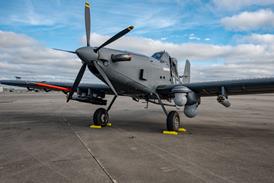As speculation rose to fever pitch over the possibility of USAir selling out to United Airlines or American Airlines, all participants concerned stressed one word to describe the current state of the deal: 'preliminary'.
Whatever the outcome, sources at USAir stress the talks are a culmination of a two-year evaluation of the carrier's core business, and how to maximise it. The 'core' (north-south traffic along the US east coast) survived the invasion of Continental's failed, low-cost Lite operation, which made its strength 'infinitely clear,' says an airline source. With financial stability returning this year, it became apparent that USAir's retrenchment from the western US markets three years ago had left a void. The choices facing the airline then became threefold: grow naturally, acquire another carrier, or find a buyer.
However, other factors were clearly playing a role. Costs were still the industry's highest, and the failure of a cost-cutting programme instituted last year was dramatically underscored in July when $2.6 billion in concessions from labour did not materialise. Insiders complain of a company culture that simply cannot carry through on tasks.
And though both USAir and its 24.6 per cent equity-holding partner British Airways have profited from a codesharing alliance, doubts about USAir's future have damaged the commitment to a long-term partnership. Moreover, BA's net revenue gain of $100 million annually dwarfs the estimated $25 million for USAir. There is a mistrust between both partners and BA has indicated it would like to be out of the alliance, says a senior USAir source.
Though there was a concerted effort to market the airline to potential buyers, Thomas Lagow, who was a VP at United before joining USAir in 1992 as executive vice president of marketing, is the person identified as the key player. United and USAir were considering the deal several months before they admitted to the talks in October.
While a host of operational and regulatory issues seems to preclude a merger, management received support from a somewhat unexpected quarter in mid-October: labour. Though divisions still exist between pilots, flight attendants and machinists, sources say the pilots are fully supportive of a merger with United, pointing to talks on the meshing of UAL and USAir seniority lists. Machinists, too, may support the idea: John Peterpaul, IAM's representative on the United board, has strong links with USAir's IAM chapter. Still in doubt is the position of the flight attendants, who were the first to reject the proposed concession package in July.
While American is also holding talks with USAir, most analysts feel that American's traditional growth pattern would militate against a merger. Indeed, Robert Crandall, AMR Corp chairman and CEO, has been speaking out on the regulatory burden of a merger mania that would naturally ensue if USAir were purchased. Still, AMR could benefit greatly from an alliance with BA, which many believe could happen irrespective of the outcome of the USAir talks. Don Carty, American Airlines' president, last December asked: 'Is the [alliance] dance over? It doesn't look like it is for BA.'
A review by United on a potential merger was expected by early November. But sources already say that morale at USAir is beginning to suffer simply from a fear of the unknown.
Source: Airline Business























